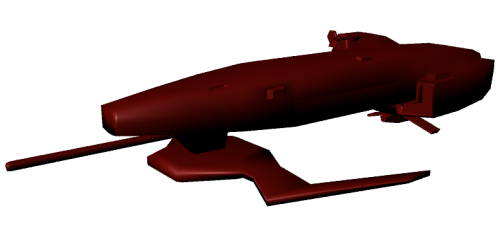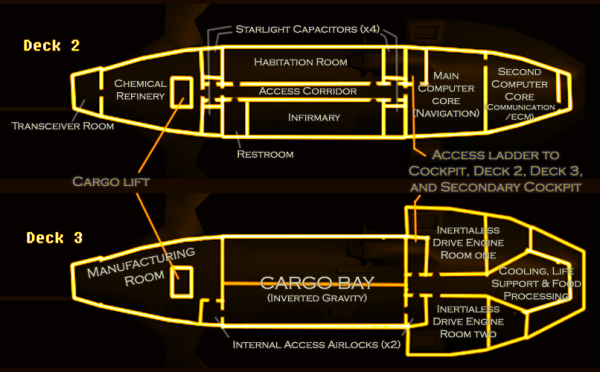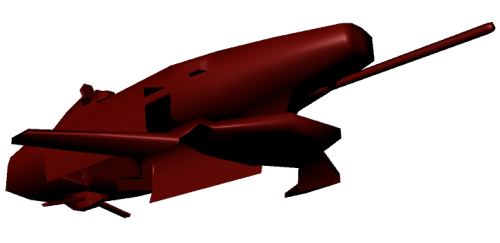Sidebar
Table of Contents
Skeleton Ensemble
Larger than a phantasm gunship but much smaller than a gypsy class industrial vessel, the Skeleton Ensemble is a peculiar one-of-a-kind Freespacer spacecraft with a long and storied past. Constantly modified by a myriad of former owners using the craft's own impressive manufacturing functions, it can vaguely be described as a small fast corvette geared for near-total independence and long-haul salvage missions. The current iteration has no outward weapons, relying on extreme stealth and agility to get by. This is not to say this was always the case, or will remain the case, however.
History
Apparently once a more conventional solar sail corvette, its burned-out and lifeless superstructure was salvaged by opportunist refugees about three months after the freespacer genocide. No record of its crew or fleet affiliation from before this time period remains.
Passing hands constantly between many vagrant owners of the northern expanse, it has since been modified beyond recognition by years of constant customization and upgrades in its many arduous journeys since. The current syntelligence, known as Jack-o-Lantern, takes the vessel's history to heart and prefers to completely avoid conflict if possible. Despite a brief stint in the Blue Rift, it has never entered Nepleslian space or been armed with NAM weapons for this reason, preferring to remain an ethereal and off-the-record presence should anything like schism ever happen again.
It is not the only vessel that lives in this isolated kind of lifestyle, so it does partake in a community of similar vagabonds on occasion. It mostly receives intelligence and trade goods from these second-hand sources even through the origins of such things are probably closer to civilized space.
As of YE 38, yet again with an entirely new crew, it is gearing up to tread further into uncharted space than ever, following on the tails of fleets and colonies that have since lost contact with the polysentience.
Statistics and Performance
Organizations Using This Vessel: The Free State Type: Stealth Reconnaissance/Transport Craft Hull Materials: Mixed steel, aluminium and titanium, some boron and tungsten superstructure Designer: Polysentience, Intelligent Design Node, Individual Crew Members Manufacturer: The Free State Production: One Crew: Up To Eight Freespacers; Can Operate Autonomously If Required
Dimensions
Length: Fuselage 50 meters (54 meters total) Width: Fuselage 7 meters (14 meters total) Height: Fuselage 7 meters (10 meters total) Decks: 4 Mass: 0.000026 to 260 Tonnes
Propulsion and Range
Type: Inertialess Drive System x2 Fuel Source: Solar Light / Radiation / Magnetism
Maximum Recommended Speed (STL): 0.42c
Acceleration (STL) In Stellar Red Zone: 0 to Max in 2 seconds Acceleration (STL) In Stellar Habitable Zone: 0 to Max in 8 seconds Acceleration (STL) In Stellar Blue Zone: 0 to Max in 20 seconds
Speed (Hyperspace Fold): 0.18 ly/m
Range: Six months assuming eight crew or less, alrough it's theoretically infinite if water, sulfur and metal ore for replacement parts are acquired on site.
Inside the Ship
The vessel has been extensively retrofitted to support a small Freespacer crew of between one and eight near indefinitely, utilizing only basic mineral supplies. It is still very cramped and contains an incredibly toxic environment compared to most familiar humanoid vessels, meaning a Nepleslian or the like is still better off staying inside their space suit regardless. None of the walls have actual fittings even in the habitation sections, making the entire interior a mess of grey bare metal panels and brown support girders, plus various coolant pipes and cables.
Almost every room has a Fire Extinguisher 🧯 and hull repair putty, and all of the compartments can be mechanically sealed and pressurized/depressurized at will, but other than that, there is no fire suppression system. Keeping the crew warm depends on reactor heat running through the coolant lines, meaning it can also get fatally cold if the ship is operating stealthily in low-power mode for too long.
Primary Cockpit
A small rectangular protrusion on the top right of the main hull, with a single-seat glass cockpit section at the front. Control is established using a direct neural jack, but can also be done manually using the backup control stick, remotely, or directly by the syntelligence system.
The roof is only about a meter and a half high, and there is exposed superstructure and wiring everywhere. Lengthwise there is also only space for a single additional occupant, presuming they sit on top of the pressure hatch directly behind the pilot's seat. The rear wall contains a large navigation computer bank, linking directly to the sensor systems attached directly to the exterior of this section.
Yes, this means that the crew is expected to “eyeball it” half the time; But being spacers, the pilot is likely a cyborg.
Polysentience Transceiver Room
Because the craft is designed to operate so far from the other fleets, it requires a dedicated radio room in the nose cone. It's an absolute mess of wire bundles and humming computer decks.
Provided they are willing to go without the polysentience for a few minutes, however, the huge evanescent wave coupler attached to the exterior can be temporarily re-purposed as a powerful radio wave sensor from here, if needs be.
Chemical Refinery
The upper nose cone section is occupied by a large chemical refinery system. Accomplished using miniature gravity-drive assisted distillation and electrolysis devices depending on the material in question, it can process many forms of ore and gasses into useful chemicals, such as oxygen for life support, sulfur for use in the ship's food processing system, and metals for use in the manufacturing room. As well as pipes leading directly to these systems, there are also four large pressure sealed caskets that can store either liquids or gasses, and an small elevator system for transporting said containers to and from the manufacturing room.
Central Corridor
A single narrow corridor that spans the entire middle upper level of the fuselage. Both ends have constantly humming starlight capacitors built directly into the walls. There is direct access to the forward chemical refinery, port habitation and starboard infirmary rooms, as well as the rear computer room. A ladder-shaft near the aft, next to the computer room door, gives access to the main cockpit, the cargo bay, both engine rooms, the life support room, and finally the secondary cockpit on the belly of the vessel.
Habitation Room
A series of eight combo sleepingbag-hammocks are attached to the walls in four columns of two. The long and thin room is somewhat spacious, but is almost always filled to the brim with personnel supplies, including food, entertainment, trade items, spare voidsuit components, and general survivalist gear. There is a temperamental miniature combination electric cooker / microwave oven on the aft-most corner, free for anyone to use, but in lieu of a fridge, perishable food is often simply left in the cargo bay where it is cold anyway.
Infirmary
A mirror image of the habitation room in terms of shape, but a large portion is taken up by an automatic cybermedical table with several robotic arms that the ship's healer is intended to directly interface with. Much like the manufacturing room there are many cabinets filled with random medical tools of various ages and states of repair. There is also a person-sized sterilization / quarantine tank, which is also the only shower on the vessel. The forward wall also contains a small 1 x 1 meter air sealed chamber with a toilet, which is piped directly to the chemical refinery for breaking down.
Starlight Capacitors
Four large integrated power stations, two at the front and two at the back of the central corridor, serve as the vessel's main battery reserves.
Computer Core
The rearmost room on the upper level contains the main computer systems, including navigation, communication, polysentience processing, prism-shield system dynamics, inertialess drive control, sensory configuration, and the syntelligence's main processor banks. It can actually get dangerously hot when complex calculations are being performed, even through it is water cooled.
Manufacturing Room
The lower-front room in front of the cargo bay is a large fabrication center, containing everything the vessel needs to completely rework itself, and any cyborg crew members on board. There are many, many random tool items strewn around the floor and hooked up to the walls, in various stages of disrepair.
The left of the room contains a formidable high-power furnace that channels heat safely down through an independent cooling system, directly connected to the the prism-shield sails below, and the right side of the room contains a multi-armed automatic assembly bench with all manner of moldings and assembly tools. Directly at the center of the ceiling is the access lift to the chemical refinery, and the rearmost wall allows access to the airlock that leads to the cargo bay. About four junker drones are typically seen recharging here, prone to being used as stools, since there are no seats.
Cargo Bay
The largest single room in the vessel, the gravity is generally turned upside down in here, due to the fact that the entire compartment can open up using a huge pair of access doors that cover almost half the underside of the vessel. There are airlocks in both the front and rear, which are the primary methods of accessing the interior of the vessel.
There is about 24 x 5 meters of cargo space, not including the large portion on the right side taken up by the telescopic crane arm system which runs the entire length of the bay by itself. Items are typically left to be secured by gravity alone, but can be chained down to integrated loops in the floor panels given enough time and effort.
Second Cockpit
An almost identical module to the primary cockpit, except mounted upside down at the rear-center of the vessel, this booth is mostly used for controlling the cargo bay's crane-arm in most normal circumstances. In emergency scenarios it is fitted to be used as a back-up main cockpit… But has an enormous blind spot at the front, since it's view is blocked by the prism shield sails' superstructure.
Life Support / Food Processing System
This central-rearward compartment on the bottom floor is dominated by a huge aquarium, and all sorts of water filtration and ventilation devices. The water tank is constantly being supplied with sulfur-enriched hot air from the engines, replicating the exact environment of a seabed hydrothermal vent, crustacean-based ecosystem and all. Rather than conventionally farmed hydroponic plants, this is a constant source of protein-rich sustenance for crew (!). It can also produce large quantities of edible algae, but typically this is used to feed the crabs unless they are running low.
Inertialess Drive Engine Rooms
The vessel contains two large rooms on the lower deck, bulging out noticeably from the rear of the ship. These both contain a separate Inertialess drive system, used in tandem to produce an impressive overall output. They can be repaired whilst operating even inside the vessel, or operate independently if the other engine is completely out of commission.
Secret Grotto
Accessible only by squeezing through a small hatch on the rear of the computer core, there is a tiny extra room, too small to even stand up inside. Several plants sit in environmentally sealed glass jars, and there is a small stockpile of paints and whitewashed canvases. There is only one lighting feature hanging from the ceiling, and somebody keeps leaving a neon green light bulb in it. Two hard drives are duct taped to the underside of a petite wooden stool, one labeled “harmony”, the other “individuality”. It's said the local area network hub for the 'spooky house' is hidden in here somewhere.
poly://spooky_house.jol (Virtual Space)
The resident polysentience recreational VR site, hosted by Jack o Lantern from the servers on the ship. It looks like a strange series of cartoonishly spooky mountain tops connected by bridges, with lounge chairs, video game consoles, and a lavish bar. It's accessible not just to crewmembers, but also anyone with access to the polysentience, meaning many strange travelers may come and go in the course of a day. Registered crew members typically have permission to spawn virtual objects in from their own files at will.
Ship Systems
Important Note; This vessel is not designed to work on planets with atmospheres. It can physically fly inside of them, and even hover reliably using it's gravity-manipulating drive system, but has zero ability to actually land. The fragile power management systems are all on the belly…
Inertialess Drive
The same basic propulsion system as the regular Phantasm, only massively scaled up, it can motivate the entire vessel by changing it's mass relative to other objects, giving it superior agility when close to large astronomical bodies.
The downside, however, is that this antigravity effect requires more and more energy the further the vessel is from said objects, and thus the effect diminishes the greater distances the vessel is away from a suitable power source or a large object to “push off” from.
It can also double as an FTL engine by generating continuum distortions, but understandably this cannot be recharged unless jumping directly into another suitable star system radius. This makes efficient power management and guidance from a dedicated stellar navigator practically mandatory.
Prism Shield-Sails
A pair of over-sized directional force field projector 'wings' are attached to both sides of the lower pylon on the front of the craft, vastly increasing the vessel's ability to absorb magnetic fields and stellar energy for its own use. It can also absorb energy attacks somewhat, adding their power directly to the vessel's starlight cell clusters.
When running in low-power “quiet mode”, they can also be used to manipulate ambient energy levels to disguise the vessel as another vessel or random debris, giving it a somewhat chameleonic effect. In combat, it functions as standard shielding of a low-to-average quality level.
Starlight Cells
Despite all of the weird modifications, the Skeletal Ensemble is still effectively solar powered and uses the standard Freespacer composite voltaic cells to drive itself, contained within the lower front pylon. They are recharged continuously by the shield-sails whenever the vessel is in the vicinity of a star, or even a large gas giant.
Despite a somewhat increased independence technically speaking, all of the power systems still require direct sunlight to be recharged. Operating in the shadow of a planet is not a good idea unless significant inertia is built up beforehand.
Starlight Capacitors
The energy harvested from the starlight cells are stored in four very high density capacitor banks located around the middle of the vessel. At full charge power reserves last for 96 hours of low-intensity shield use (passive sailing or running silent), or alternatively 30 minutes of high-intensity shield and propulsion use (combat mode).
Hyperspace jumps require at least two-thirds of a full capacitor charge. In high orbit around a star's corona, a full capacitor recharge takes only two hours.
Savant Computers
The entire computer system and networked junker system is controlled by a single syntelligence. This program can operate the vessel entirely independently, including the cargo bay's crane arm, but their ability to self-repair and self-regulate is massively diminished in lack of an organic crew. The external cameras are also extremely lackluster, meaning the Syntelligence will often request direct visual feeds from cyborgized crew members.
Evanescent Wave Coupler
The standard means of FTL communication by the Freespacers, allowing the transfer of huge quantities over long distances or the coordination of fleet maneuvers. This system is backed up by secondary radio and laser communication systems.
May also be used to sap energy from compatible wireless energy transmitters, meaning these units have effectively unlimited energy assuming there are enough support vessels in proximity to power them.
Particular to the Skeleton Ensemble, the huge forward mast on the exterior of the vessel gives it a considerably longer range of communication than most, allowing for good polysentience connection speeds even dozens of light years away from the nearest friendly vessel.
Heat Radiation System
Because the vessel creates a great deal more heat than the Phantasm, it requires the two heat radiation panels sticking out of the secondary cockpit, in order to keep it's heat levels in check. They can be turned off in order to activate a sort of “stealth mode”, but internal heat levels will build up to catastrophic levels in as little as thirty minutes if the ship is operating at full speed with its shield up.
If this system is damaged, it is imperative that the cargo bay doors are left open at the very least.
Utility Systems
Heavyweight Telescopic Crane Arm
Location: On the bottom, can retract inside cargo bay doors Primary Purpose: Salvage Secondary Purpose: Starship Grappling & Demolition Range: 22 to 68 meters Size Of Hand (Closed): 1 x 1 meters Size Of Hand (Open): 1 x 1.5 meters Maximum Load: 10 to 30 Tons~
Whist not at all a weapon system, the crane arm paired with the ship's ability to increase it's mass results in an surprisingly sturdy telescoping arm system. This can be used to pull parts off of other vessels, break open hulls, grapple small shuttles, or even anchor the ship down should the situation require it.
The limits of this ability are the load tolerances of the arm itself, although this can be tripled if the arm is retracted back to it's minimum length. There is also an independently movable camera system above the palm of the arm's four-fingered grappling hand, allowing it to be used for things like investigatory probing, and fine manipulation.
OOC Notes
Primitive Polygon created this article on 2016/01/30 18:20.
To do list; Hull materials, complete 3D model.
Page Tools
Terms of Service - Privacy Policy



